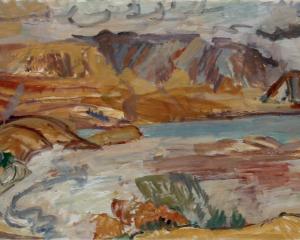James Dignan takes a look at the latest exhibtions from around Otago.
"Past and future clouds" (Dunedin Public Art Gallery)
New Zealand is blessed with a fine, varying landscape, which from early days has been a constant source of inspiration for our artists.
An often overlooked aspect of these landscapes, however, is the panoramic sky which complements the land, providing the yin to the weighty yang of terrain and waters which are usually interpreted as the subject of this form of art.
"Past and future clouds" attempts to partially address this neglect.
In a series of paintings drawn from the gallery's vast permanent collection, the country's cloudy skies are brought front and centre.
The land becomes merely the counterpoint to cloud continents in works by such diverse artists as Marilynn Webb, Philip Trusttum and Colin McCahon, evoking moods and often providing dynamic movement to pin the land below into static solidity.
In many ways, the most impressive of the works are those where land and sky merge imperceptibly into one another.
These include a forceful Toss Woollaston Westland scene and an arresting William Sutton work, which dominates one wall.
In other cases, such as Anna Caselberg's St Kilda beach scene, the tone of the work is determined almost entirely by the moody skies depicted.
The exhibition is capped off by a piece of modern sculpture, Peter Robinson's polystyrene cloud form, Nimbus.
"Polyneitus Spring", Andy Leleisi'uao (Milford Galleries)
The work of Andy Leleisi'uao continues to impress in his latest exhibition at the Milford.
The artist has created a frieze of panels, each entire and separate but all flowing together to form an arcane narrative.
The images show a strong influence of classical Middle Eastern and Egyptian hieroglyphic art, imbued with a Pasifika overlay - Sumerian meeting Samoan in a pan-global aboriginal art form.
The personal language created hints at, but does not reveal, its intriguing tale.
Motifs recur within the works: concentric red and black, and single black circles; hands reaching from below and above symbolically giving and carrying; and the shimmering misty borders which edge the black figures.
The basic palette is reminiscent of tapa, over which is scattered blobs of brightly coloured paint, as if we are looking at the action through a fantasy fairy-rain, seeing images from a nether world.
Alongside these images is a series of bold, well-worked drawings which may or may not be preliminary works for the paintings.
Whereas the painted figures are vaguely, blurrily edged, these graphite works are drawn with a firm confidence, their smooth, weighty lines delimiting and reflecting the power of the figures drawn.
All the works are fascinating, well worked, and reveal new facets with repeated viewing.
"Suicide Pavilions", Simon Esling and Clara Chon (Blue Oyster Gallery)
Siimon Esling and Clara Chon have created a provocative, thoughtful exhibition at the Blue Oyster. Esling's interests in the psychological and human element in architecture and Chon's inspiration from suicide and its collateral damage have come together to produce an examination of the thoughts which lead to suicide, expressed by means of allegorical architecture.
The items displayed are predominantly suicide notes and sketches.
The sketches form dark psychic architecture.
They are designs for pavilions - places of refuge and contemplation - each reflecting a specific frame of mind.
The notes, mainly real, are largely drawn from coroners' reports.
Alongside these is text from Herman Hesse's Steppenwolf, its protagonist's thoughts of suicide as a means of longed-for yet unwanted escape leading to mental vacillation between the will to live and the desire to die.
The centrepiece work is a painting of artist Mike Kelley, who committed suicide earlier this year, over which has been placed a leather harness suggesting an analogy between release through self-inflicted death and relief through masochism.
This work serves as a reminder that many artistic geniuses, from Van Gogh to Rothko and beyond, have fallen prey to their inner darkness.
Chillingly, nearby lies a length of rope Esling bought years ago when contemplating the same act.









![Untitled (c. mid 1990s, [pink 3]), by Martin Thompson, 415mm×590mm. Photo: courtesy of Brett...](https://www.odt.co.nz/sites/default/files/styles/odt_landscape_small_related_stories/public/story/2024/02/untitled_pink_3.jpg?itok=Q0aQrc9o)


